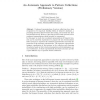Free Online Productivity Tools
i2Speak
i2Symbol
i2OCR
iTex2Img
iWeb2Print
iWeb2Shot
i2Type
iPdf2Split
iPdf2Merge
i2Bopomofo
i2Arabic
i2Style
i2Image
i2PDF
iLatex2Rtf
Sci2ools
KDID
2004
2004
An Automata Approach to Pattern Collections
Condensed representations of pattern collections have been recognized to be important building blocks of inductive databases, a promising theoretical framework for data mining, and recently they have been studied actively. However, there has not been much research on how condensed representations should actually be represented. In this paper we study how condensed representations of frequent itemsets can be concretely represented: we propose the use of deterministic finite automata to represent the condensed representation and study the properties of the automata representation. The automata representation supports visualization of the patterns in the collection and clustering of patterns based on their structural properties and interestingness values. Furthermore, we show experimentally that finite automata provide a space-efficient way to represent itemset collections.
| Added | 31 Oct 2010 |
| Updated | 31 Oct 2010 |
| Type | Conference |
| Year | 2004 |
| Where | KDID |
| Authors | Taneli Mielikäinen |
Comments (0)

